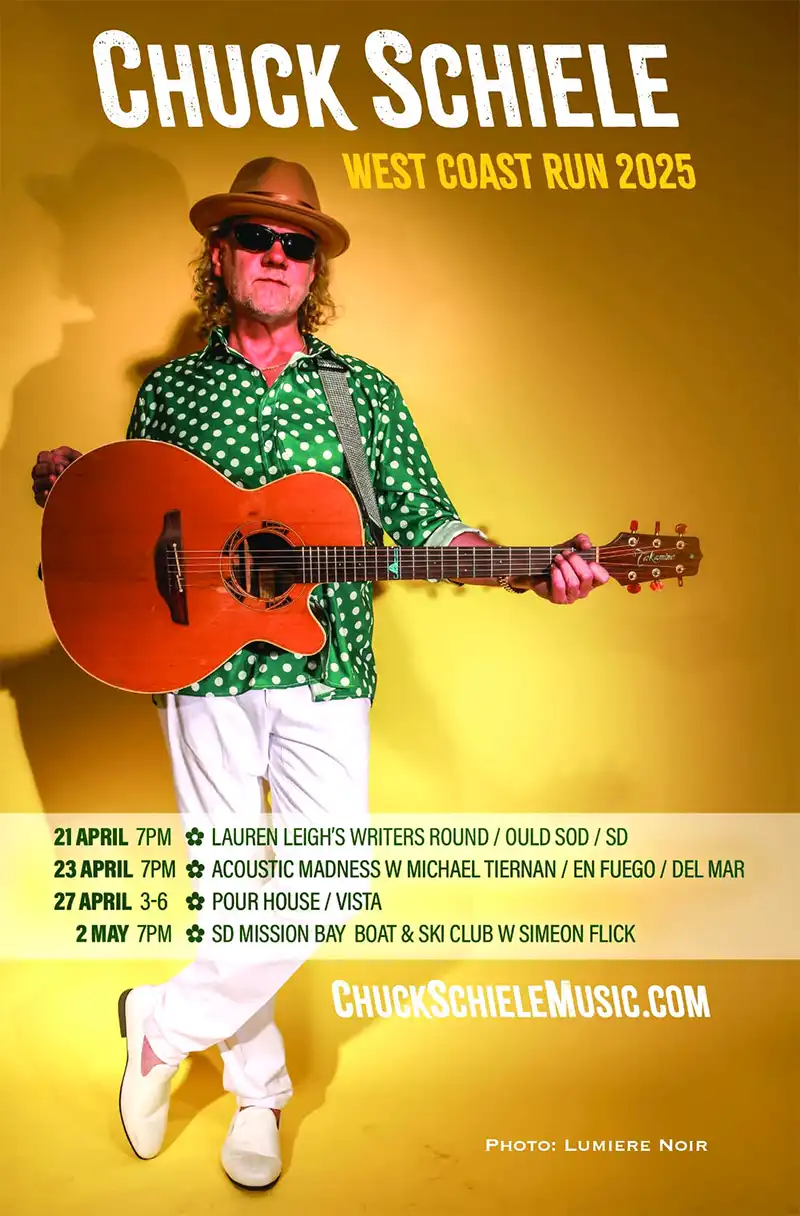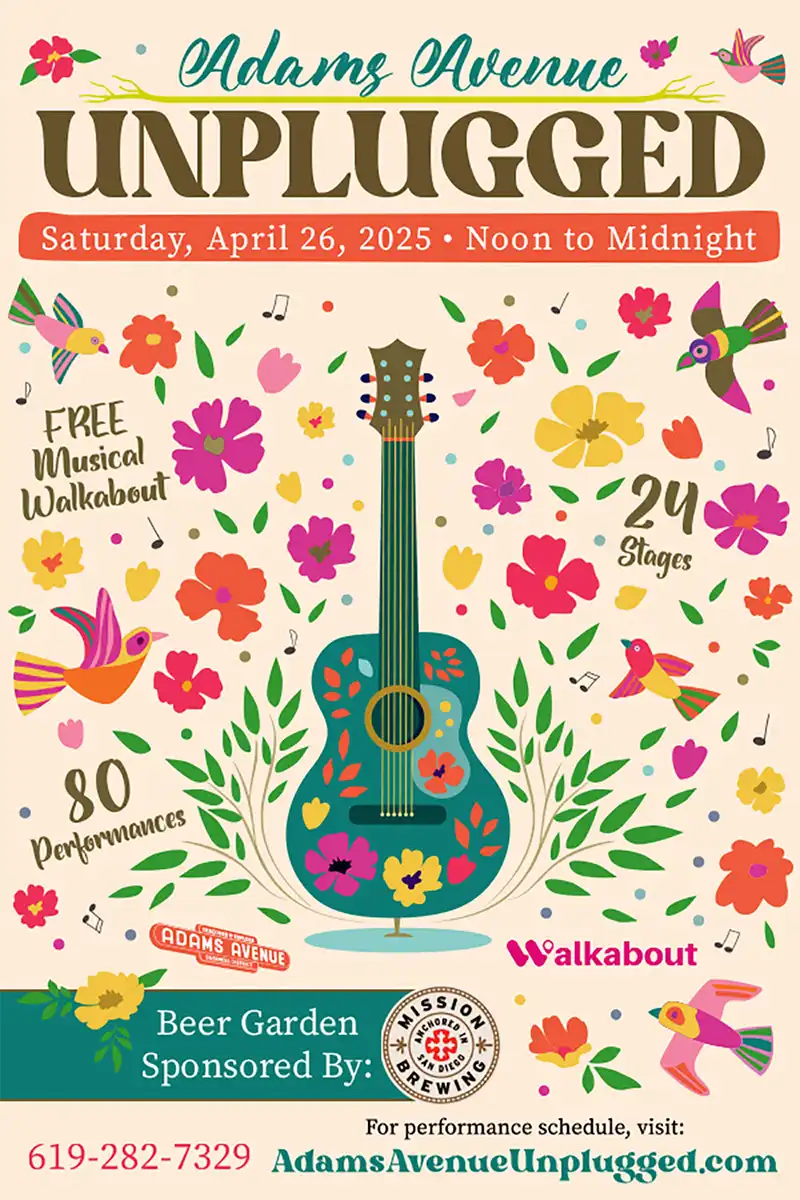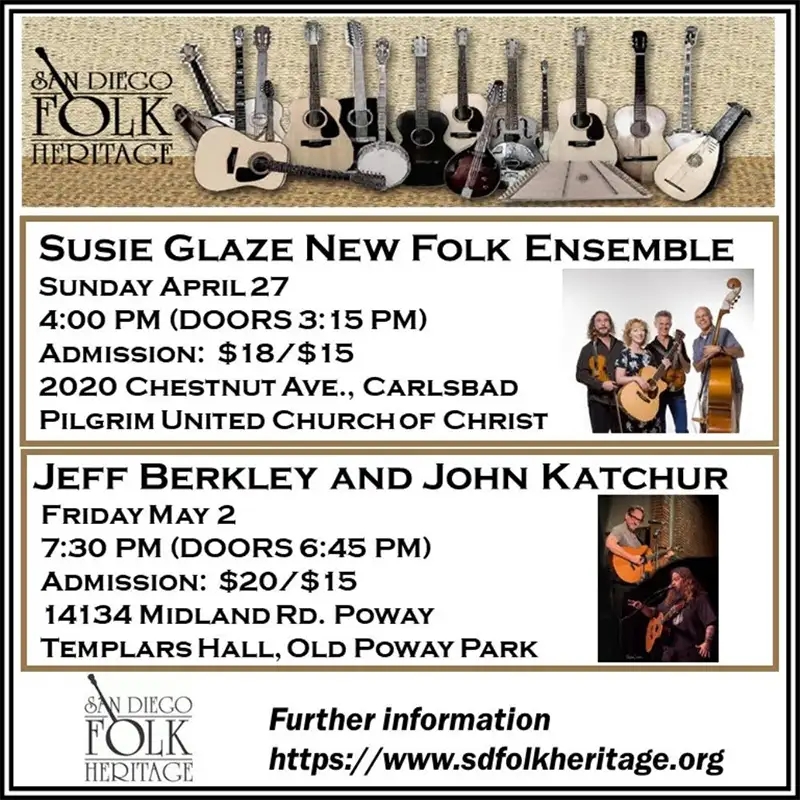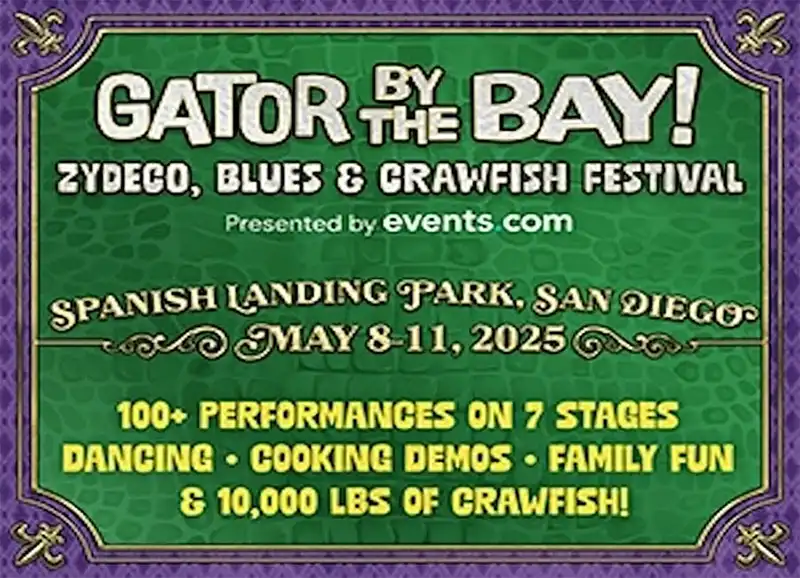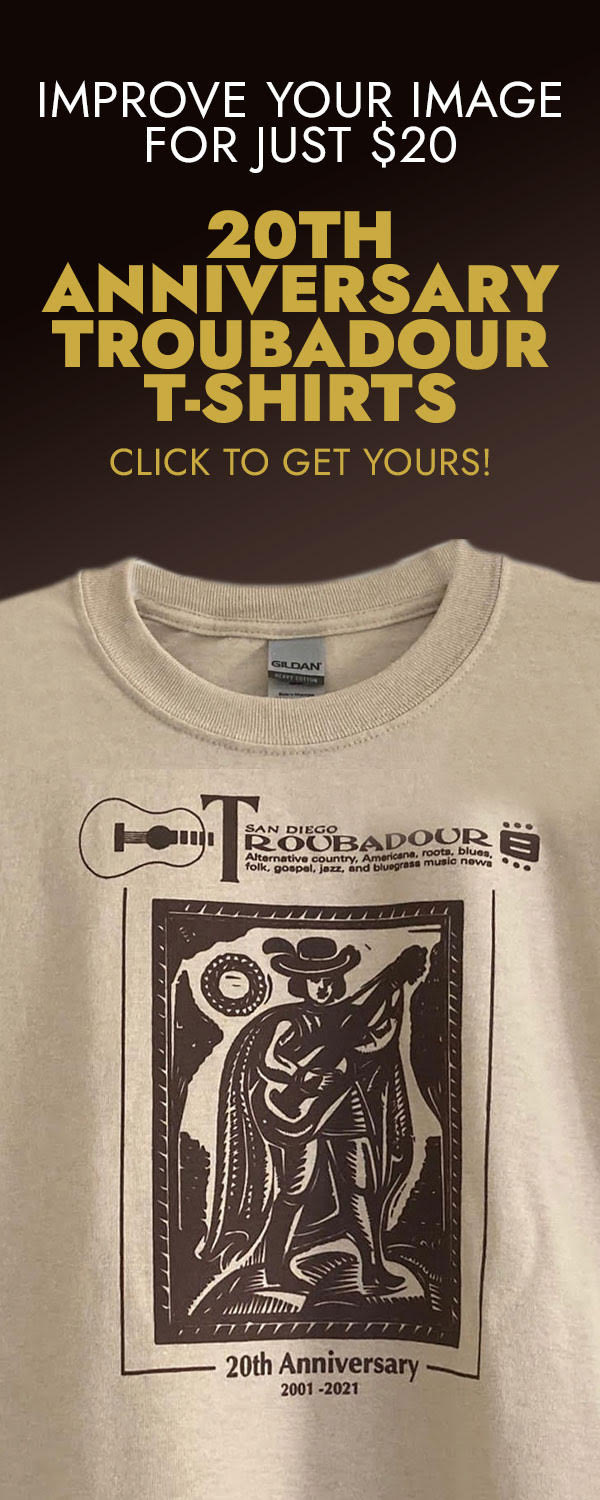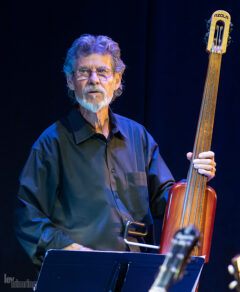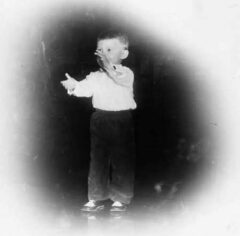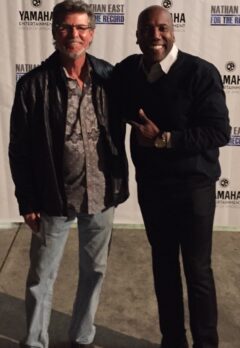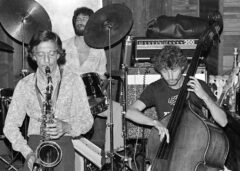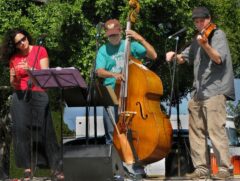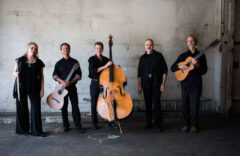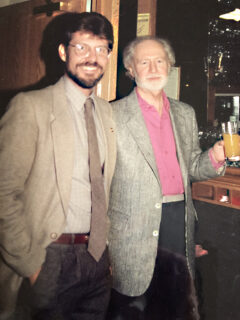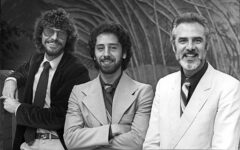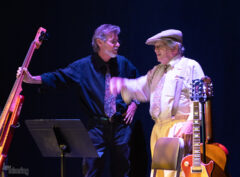Cover Story
Gunnar Biggs: Stalwart on the Upright
When asked what inspired him to take up the bass, Gunnar Biggs sums it up in two words: Paul McCartney.
In 1964, Biggs was a fledgling French horn player, following in his father’s footsteps. The late Millard Biggs was a virtuoso of the brass instrument and taught at San Diego State University.
Seeing the Beatles in their debut U.S. TV appearance on the Ed Sullivan Show revolutionized the boy’s perspective.
“When I was 13, I saw the Beatles and I wanted to be a bass guitar player,” he said. “So it started February 9, 1964. …
“The day after that I told my dad I wanted an electric bass. He said he’d get me an electric bass if I learned how to play the double bass at the same time.
“If I have one thing to thank my dad for, among many things, it would be that that was really wise advice because that’s what diversified my portfolio. He was a cool guy. He was very humble and he affected so many students of music in a positive way.”
Gunnar Biggs’ résumé as a virtuoso of the double bass—also called upright bass or contrabass—is vast. For five decades, Biggs has been an ubiquitous presence on the San Diego music scene, whether he plays jazz, classical, blues, or bluegrass on stages, clubs, coffeehouses, or classrooms.
Drummer Kenneth Koch has been a frequent collaborator over the years, especially in jazz settings.
“Whenever I would be on a gig with him, the first couple of measures always put a smile on my face. It just made it easy to play,” said Koch, a veteran of many San Diego-area bands.
As Koch explains, Biggs has a unique rhythmic sensibility.
“My favorite thing about Gunnar: Somebody counts out a tune and we seem to share it in the same place, just where he puts the beat, especially when he’s playing straight-ahead time, quarter notes on bass.
“It’s hard just to play quarter notes and make it feel like it wants to swing. That’s one thing that Gunnar can do really well.”
Biggs has a striking ability to quickly transition from plucking the strings to caressing them with a bow. The “arco” technique is especially effective on ballads, and a necessity for most classical pieces.
“While it is a cliché that listeners’ ears tend to tune out on bass solos, that would be a mistake when listening to Biggs—whose forays shine as much if not more than the soloists he is supporting.
“He seamlessly entwines two- and three-note chords and ventures into the instrument’s upper register while retaining perfect pitch. That is not easy,” Koch said.
The acoustic bass lacks the frets that provide visual guides to the right notes on the electric bass and guitar. Upright bass players must learn to hit the right pitch by ear.
“The placement of your hand and your finger on the strings is all you’ve got to go with to get perfect intonation. So, he’s spent a lot of time on that,” Koch said.
FROM ZANESVILLE TO MONTEZUMA MES
Gunnar arrived in San Diego at the age of four when his family relocated from Zanesville, Ohio, after his dad landed a position at San Diego State.
After discovering the electric bass and starting to study the acoustic upright, Biggs experienced an epiphany.
“Everybody needs a bass player,” he said. “This one instrument here can open doors for me all over the place. I noticed that right away as a kid. I started playing the big bass when I was 13 and got into the San Diego Youth Symphony way before I was ready.”
His first teacher was Bob Magnusson, one among many extraordinary bass players the San Diego region has produced—a much sought-after sideman and recording artist in his own right. It was Magnusson, Biggs said, who introduced him to essential role models such as Ray Brown and James Jamerson.
“Bob was telling me I should get some Oscar Peterson Trio records and listen to this guy, Ray Brown. The next thing he’d say, ‘You’ve got to learn what funk is, Gunnar.
“‘Start from the beginning. Get some good Impressions, get some good Motown and Stax. Listen to James Jamerson and those guys. Because I wanted to play electric, too. So, he was really helpful there.”
The teenager started playing in local rock combos as well as the bands at Horace Mann Jr. High School, and then at Crawford High School in the State College area of San Diego.
“We had to be in the marching band to be in the jazz band because there really wasn’t a jazz band class,” Biggs said.
Gunnar is one of the most versatile musicians I’ve had the ongoing privilege to work with—he’s so innately musical, he can go from the SD symphony to a klezmer gig without blinking (but as always, he will be smiling…and telling hilarious jokes). In a town that has a wealth of brilliant, world-class bassists, I always consider myself lucky if we’re on a gig together. I would carry his amp if he asked cme to. (Please don’t ask me to carry your amp).
—Elizabeth Schwartz
CRAWFORD KIDS
At Crawford High School, Biggs found himself among classmates who would become illustrious in the musical annals of San Diego, Southern California, and the world.
Bassist Nathan East would become internationally renowned for his role in the jazz-fusion group Four Play and in Eric Clapton’s band, among many others; keyboard maestro Carl Evans Jr. was the linchpin of the jazz-fusion-funk band Fattburger, which unintentionally helped initiate the “smooth jazz” movement.
Reed player Hollis Gentry Jr. was a fixture on the San Diego jazz scene for several decades and performed gigs and recordings as part of Fattburger. Gentry had many stints over the years with luminaries such as trumpeter Freddie Hubbard and guitarist Larry Carlton.
East, Evans, Gentry, and drummer Skipper Ragsdale formed the funk-jazz group Power, which was so impressive they were hired by Barry White to perform with his Love Unlimited Orchestra.
Of his relationship with the late Gentry during that era, Biggs said, “We were besties, man.”
He described the time he spent around the Power band members and other African-American musicians at the El Cajon Boulevard and 54th Street campus as expanding his consciousness.
“I aspired to be black because of all the cool kids at Crawford,” he said. “It was a really fluid, comfortable situation,” he said.
Biggs recalls that he and Gentry went to band camp together in Utah. One day they decided to look for something to eat.
“We were walking around Salt Lake City and we came in [to a restaurant] and it was so hostile, they made us wait. We decided maybe we should just split and get a hamburger somewhere else. But it was a cold thing … and I didn’t understand it.”
On the bright side, Biggs said, he and Gentry won outstanding musician awards and also met Lou Marini, who was renowned for playing saxophone in the Blues Brothers band. Marini would be of help later in Biggs’ musical development.
At Crawford, Biggs played in award-winning stage bands under the leadership of Dennis Foster that have become legendary. In addition to the musicians in Power, the school in the late ’60s and ’70s produced such future stars as pianist Mel Goot, drummer Doug Robinson, saxophonist Paul Bunuan, trombonist Dan Regan, and singer Sandi Patty.
To qualify for the jazz band, Biggs had to participate in marching band, which required him to play percussion and tuba, abetted by his experience on French horn.
“It was the springboard,” Biggs said of Crawford. “People still talk about the Crawford bands. My senior year, I think we won every single Southern and mid-California jazz festival for our division. … People knew us.”
Crawford graduate Dave Drexler, who became producer of the San Diego jazz station KSDS-88.3’s award-winning “Jazz Live” concerts, recalls Biggs from his high school years.
“In fact, Gunnar and my brother were in the band together,” Drexler said. “Gunnar was always a whiz kid.”
Since Gunnar’s father was a stalwart among San Diego State’s faculty, it wasn’t long before the son found himself in older company.
Gunnar has played several shows with me over the last several years and along with my appreciation of his great playing, reading, listening, and musicianship he continues to surprise me with anecdotes from his past. For example, I wanted to perform an arrangement based off the Nelson Riddle arrangement of “Route 66” from the TV show. I asked Gunnar if he was familiar with that version. He replied that he had once played that arrangement with the Nelson Riddle Orchestra.
Having played many years with Mose Allison, there was a time when somebody told Gunnar that there’ was an English fellow who wanted to speak to him. Gunnar said “yes” and the fellow turned out to be Peter Townshend (from the Who), who is actually a big fan of Mose Allison. Gunnar said he was impressed with how much Peter knew about Mose.
—Robin Henkel
MOVIN’ ON UP
“I actually started when I was a junior in high school, playing bass with the San Diego State Jazz Ensemble because their bass player graduated,” Gunnar said. “So here I was in high school and I was the bass player at San Diego State. That got me in with the older guys.”
A couple of the SDSU musicians were playing in the rehearsal band of orchestra leader and trumpeter Don Ellis, known for his challenging compositions and arrangements, often framed in unusual time signatures.
“They said, ‘You ought to come up with us. Don has this book for three bass players. It was a weird book, man. And they said, there’s only two (bass players).
“So when I was 16 or 17, they started dragging me up to the rehearsal space in L.A. and I played with that for a while. Because of the classical training, I could read really well. So people would throw a chart in front of me and I’d sight-read it down.”
The older musicians urged him to consider attending North Texas State University for its jazz program. Now known as the University of North Texas, North Texas State in the ’70s was one of the few colleges that had a jazz-oriented curriculum, and it arguably was the best of them.
Biggs followed the advice, auditioned for North Texas State, and was accepted.
“They had the award-winning college big band in the nation for years,” he said, referring to the group labeled the One O’Clock Lab Band in reference to its daily rehearsal time slot.
Participating in the celebrated program opened up more doors.
“In my first week at North Texas State, I was walking to my dorm and I heard this killer combo rehearsing in this little building right off campus,” Biggs said. “So I opened the door and looked in, and I heard, ‘Gunnar?’ I looked up and it was Lou Marini.
“He said, ‘Come on in, man.’ We shook hands. He introduced me to the band, which were all the gods from the One O’clock. And the next thing, he says, ‘Are you working Saturday?’ ‘No, I just got here, man,’ I said. ‘I don’t have a car. I’ve just got my bass.’
“He says, ‘That’s okay. We’ll pick you up.’ So I started working with those guys in Dallas.’”
Gunnar and I have worked together over the years here and there. He’s a treasure and we had the love of bass player Preston Coleman in common. He took lessons from him and I had the pleasure of being mentored by him in my band, Tobacco Road, for years. Gunnar has a charming wife, Bonnie.
—Sue Palmer
CLASSICAL MOVEMENT
During his second semester, Biggs said, he was in his room practicing a classical piece when there was a knock on the door. He opened it to find a young woman there who said, “Play that again.”
“I played it and she said, ‘Follow me. Bring your bass.’ She took me to the office of the [classical] orchestra director. And she said, ‘Play that thing for him.’
“I was working on a concerto and I played it and he went, ‘Where did you come from?’ because I was a jazzer, not a stringer (in the classical program). …
“And he said, ‘Well, how would you like to be principal bass in Orchestra A?’ And I went, ‘Sure.’ I just fell in love with the classical thing.”
At the urging of UCSD professor and contrabass teacher Bert Turetzky, Biggs decided to switch his major from dance band to classical performance. Despite its reputation, North Texas did not have a jazz studies major then.
“He said, ‘What are you going to do with a degree in dance band? Are you going to play bar mitzvahs for the rest of your life?’”
Biggs said he became disillusioned with the prospect of making North Texas’ One O’Clock Lab Band. He and other students in the pipeline were bumped in the pecking order after Woody Herman temporarily disbanded his band and many of his musicians enrolled in North Texas, immediately jumping into the One O’Clock Lab Band.
Returning to Southern California, Biggs auditioned for the San Diego Symphony and was hired as one of the orchestra’s three bass players. He was in rich company. The others were Peter Rofe, now in the Los Angeles Philharmonic, and Mark Dresser, who carved out a career as an innovative improviser and is now on the UCSD faculty.
RICH EXPERIENCE
After a couple of seasons with the symphony, Biggs was hired to play electric bass for the Buddy Rich Big Band. It was during a phase when the orchestra was playing more rock-oriented charts, following the success of his album Mercy, Mercy. The title came from the band’s arrangement of the Joe Zawinul tune “Mercy, Mercy, Mercy,” a hit while he was with the Cannonball Adderly Quintet.
“So, I flipped back into the jazz thing,” Biggs said. “That opened a lot of doors and closed a lot of emotional doors, working with Buddy. It was ridiculous, wonderful and terrible, the best of times and the worst of times.”
While a drummer of extraordinary prowess, especially in the big band idiom, Rich was notorious for his mercurial, irascible temperament.
“He fired me three times and some people say, ‘Is that all?’” Biggs recalled. “But the third time, I finally said, ‘No, I’m done.’ We were in Chicago.’”
Biggs spent some time in Chicago, then gigged around Minneapolis before returning to San Diego.
Gunnar is not only an exceptional musician, he is a true “khaver,” a compadre you can always count on.
—Yale Strom
BACK IN TOWN
“I moved back here in 1976 and couldn’t believe what a great scene we had going here,” he said.
From the mid-’70s through the early ’80s a number of venues around town featured jazz, including the Crossroads downtown, Chuck’s Steakhouse, the Blue Parrot, Elario’s in La Jolla, and the two Triton restaurants in Cardiff and the State College area.
Ingrid Croce, the widow of pop star Jim Croce, opened Croce’s club and restaurant downtown in 1985. Many other spots, like the Aspen Mine Company in State College and the Halcyon near the Sports Arena, intermittently hired jazz combos.
Back in San Diego, Biggs reunited with Gentry and other old friends. He bonded with pianist Butch Lacy, a virtuoso equally at home playing a sizzling bebop number, a rocking blues or a wistful ballad. He had backed up many jazz luminaries, toured with superstar vocalist Sarah Vaughan, and often teamed in San Diego with Ella Ruth Piggee, who enthused crowds with her gospel-tinged soul-jazz vocals.
Lacy and Biggs formed a duo and got a regular date at the Islandia, where the bassist would meet his future wife, Bonnie.
“That was a ridiculous gig because people would come in from out of town that already knew Butch,” Biggs said. “[The management] paid us very well and didn’t ever tell us what to play.”
Biggs’ friendship with the pianist persisted even as Lacy moved to Denmark. Following Lacy’s death in 2018, Biggs was among those on the bandstand to pay tribute in a memorial concert at Dizzy’s jazz performance space in San Diego.
Remembering Lacy, Biggs said he was impressed by “the magnitude of his presence. He was a big man and he had a big spirit. Everybody was welcome. He came from a place of love and support. He didn’t try to demolish you if you weren’t playing up to what was expected. He would help you play better instead of trying to bury you.”
Koch, who came to San Diego from Los Angeles to play with guitarist Peter Sprague, recalls the Islandia gig and Biggs’ role.
“He was playing there with a duo, with Butch Lacy—just Butch and Gunnar,” Koch said. “I was so impressed with how well these guys sounded, I asked if I could bring my drums in and just play for free. And Butch was like, ‘Yeah, for sure, man.’
“So I would go down there and play for free. Eventually, when they got another gig at Elario’s, they hired me to come and play drums and actually paid me. That worked out pretty well. Butch and Gunnar had a special thing going on back then.
“I was glad they let me (sit in), because I learned a lot doing that. Butch’s time feel was so deep, and Gunnar had a great feel always.”
STRETCHING OUT
Biggs became the regular bass player for the legendary jam session hosted every Sunday by Jimmy and Jeannie Cheatham, nationally renowned jazz veterans who reveled in Kansas City swing. The session was an institution for years from the mid-’70s to mid-’80s, starting at the airport Sheraton on Harbor Island and then moving to the Bahia Resort on Mission Bay. Jeannie Cheatham, who was entrenched at the piano, served as the emcee and gave nicknames to the regulars, labeling Biggs “Grooveman,” he said in an interview with Jim Trageser.
During that period, Biggs would frequently play with alto saxophonist Charles McPherson, another famous jazz transplant who had made a name for himself as a recording artist and band leader back East.
“I did that for two years,” Biggs said of the Cheathams’ jam. “You didn’t know who was going to come through the door. They would have 10 horn players lined up to play and Charles would be one of them.
“The young guys would play 25 choruses until they thought they could get it right. Charles would walk up and just play two, three choruses of the most gorgeous stuff in the world and walk off. The horn players—some of them you’d see packing up right away when Charles was there.”
For a bass player, the Cheatham’s jam was a marathon because of the nonstop blowing.
“It perpetuated a tradition of the jam session being like the main training facility,” Biggs said. “That’s where people cut their teeth. … [Jimmy] would accept everybody on every tune. …
“We’d play a blues to start, either ‘All Blues’ or ‘Straight No Chaser’ or something. It took 45 minutes to get all the horn players out there, right? And then, Jimmy would turn around and say, ‘Take One!’ And I’m like bleeding to death. …
“So I found out what it was like to really get the endurance, the physical aspect—the endurance of playing my bass and playing different tunes with different people.”
Backing up McPherson, Biggs said, was an educational experience in itself, considering the maestro’s vast experience and dazzling virtuosity.
“Charles probably taught me more about playing jazz than any teacher,” Biggs said. “He took the bass out of the picture and just dealt with the music as a whole. He would always come up and have these salient things to say to you.”
TEACHING AND GIGGING
After the Buddy Rich experience, Biggs was reluctant to commit himself to extended road trips and eagerly accepted a position as an educator on the San Diego State faculty with his father. He retired from SDSU in 2005 but still kept teaching in North County.
“Since I taught at San Diego State for 25 years, I couldn’t actually go out on the road and keep my job,” he said. “All through that time I had a lot of offers. I had an offer from Carmen McRae.
“The road was ridiculous with some of these people. They’d be out 300 nights a year. I’d had my fill of the bus life. … There are other places that are better to sleep than a bus.”
Yet, Biggs’ reputation enabled him to get plenty of short-term gigs in the region with such top-notch touring artists as virtuoso straight-ahead pianist Tommy Flanagan and jazz-blues great Mose Allison. Biggs was Allison’s first-call on bass touring this region before his death in 2016.
The association with Allison led to other opportunities, such as backing up the guitar duo of Charlie Byrd and Laurindo Almeida.
Meanwhile, Biggs continued to gig locally with San Diego mainstays Sprague, vocalist Lisa Hightower, trombonist Dave Scott, pianist John Opferkuch, and many others.
While Biggs retired from institutional academia, he still went on to teach bass privately as well as performing in a number of diverse settings.
He formed a bluegrass-cum-jazz duo called Mandobasso with mandolinist Bill Bradbury. They released an album by the same name and perform regularly, pandemic permitting.
In 2009, Biggs released his own CD, Footprint, which features the aforementioned Bradbury, Hightower, Opferkuch and Sprague, plus reed player David Borgo and drummer Duncan Moore.
BACK ON STAGE
These days, Biggs is a regular with guitarist Robin Henkel, violinist Yale Strom and his band, Hot Pstromi, and Opferkuch among others. He remains sought after by classical organizations, including the Poway Symphony Orchestra.
Over the last couple of years, the Coronavirus pandemic has severely constrained performance opportunities for all musicians. Though he did participate in some streaming concerts in coordination with Sprague, the reduced schedule gave Biggs time to reflect on his career path and realize how much he appreciates the live experience.
Biggs and Bill Bradbury as MandoBasso playing a “porchella.”
That led him, with the support of his wife, Bonnie, to keep in-person music alive with a series of low-key monthly concerts conducted from their porch in Carlsbad, events they’ve dubbed “porchellas.”
He also said he has greatly enjoyed playing live recently in club settings with Henkel, particularly his group featuring three horns, and other ensembles.
“That’s one thing I’ve missed the most is playing for people, live,” Biggs said. “You’ve got your band, you go out and play, people respond to it, and there’s that feeling that keeps you going to the next gig. I think I needed more of that.
“That’s another reason about, not necessarily being a bandleader, but taking a little control of my destiny, my direction. It got me back to the feeling I had when I first started. … So I wanted to go back to where people were out front and getting it. It felt really good, really good.”
This article is excerpted from an upcoming history of jazz in San Diego with co-author Jim Trageser.



